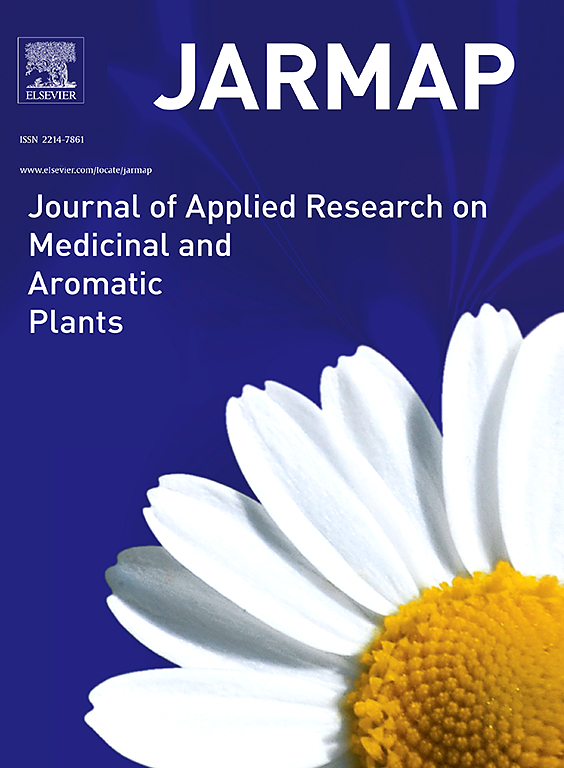Does the exogenous application of brassinosteroids affect the photosynthetic, morphological characteristics, and THC concentrations of Cannabis sativa L. under drought stress?
IF 3.6
2区 农林科学
Q1 PLANT SCIENCES
Journal of Applied Research on Medicinal and Aromatic Plants
Pub Date : 2025-04-01
DOI:10.1016/j.jarmap.2025.100635
引用次数: 0
Abstract
Drought stress represents a significant constraint on the productivity of crops globally. The application of plant growth regulators, particularly brassinosteroids (BRs), has demonstrated potential in enhancing plant tolerance to drought conditions. This study aimed to examine the effects of exogenous BR application on the photosynthetic and morphological characteristics, as well as the concentrations of Delta-9-Tetrahydrocannabinol (THC), in Cannabis sativa subjected to drought stress. A split-plot experimental design was implemented over two growing seasons, with the primary factor being the planting date (May 20, June 5, June 20) and the secondary factor being the irrigation level (80–100 %, 50–60 %, and 30–40 % of field capacity). Exogenous BR treatments (0, 200, and 400 μg/L) were applied as the tertiary factor. The results indicated that drought stress significantly diminished photosynthetic efficiency, plant growth, and THC concentrations in C. sativa. Conversely, the exogenous application of BRs alleviated the adverse effects of drought, leading to enhanced photosynthetic performance, improved morphological traits, and increased THC levels compared to drought-stressed plants that did not receive BR treatment. These findings suggest that the exogenous application of BRs may serve as a promising strategy to improve drought tolerance and the medicinal properties of C. sativa. The study offers valuable insights into the role of plant growth regulators in modulating the physiological and biochemical responses of this important medicinal plant under conditions of water limitation.
外源油菜素内酯是否影响干旱胁迫下大麻的光合作用、形态特征和四氢大麻酚浓度?
干旱胁迫是全球农作物生产力的一个重大制约因素。植物生长调节剂,特别是油菜素内酯(BRs)的应用,在提高植物对干旱条件的耐受性方面具有潜力。本研究旨在研究外源BR对干旱胁迫下大麻光合特性、形态特征以及δ -9-四氢大麻酚(THC)浓度的影响。采用两个生长季节的分块试验设计,主要因子为种植日期(5月20日、6月5日、6月20日),次要因子为灌溉水平(田间容量的80-100 %、50-60 %和30-40 %)。外源BR处理(0、200和400 μg/L)作为第三因子。结果表明,干旱胁迫显著降低了苜蓿的光合效率、植株生长和THC浓度。相反,与未施用BR的干旱胁迫植物相比,外源施用BR缓解了干旱的不利影响,导致光合性能增强,形态性状改善,THC水平升高。这些结果表明,外源施用BRs可能是提高苜蓿耐旱性和药用特性的一种有希望的策略。该研究为植物生长调节剂在限制水分条件下调节这种重要药用植物的生理生化反应提供了有价值的见解。
本文章由计算机程序翻译,如有差异,请以英文原文为准。
求助全文
约1分钟内获得全文
求助全文
来源期刊

Journal of Applied Research on Medicinal and Aromatic Plants
Pharmacology, Toxicology and Pharmaceutics-Drug Discovery
CiteScore
6.40
自引率
7.70%
发文量
80
审稿时长
41 days
期刊介绍:
JARMAP is a peer reviewed and multidisciplinary communication platform, covering all aspects of the raw material supply chain of medicinal and aromatic plants. JARMAP aims to improve production of tailor made commodities by addressing the various requirements of manufacturers of herbal medicines, herbal teas, seasoning herbs, food and feed supplements and cosmetics. JARMAP covers research on genetic resources, breeding, wild-collection, domestication, propagation, cultivation, phytopathology and plant protection, mechanization, conservation, processing, quality assurance, analytics and economics. JARMAP publishes reviews, original research articles and short communications related to research.
 求助内容:
求助内容: 应助结果提醒方式:
应助结果提醒方式:


